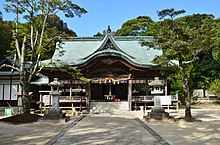| Tamanooya Jinja 玉祖神社 | |
|---|---|
 Haiden of Tamanooya Jinja Shrine Haiden of Tamanooya Jinja Shrine
| |
| Religion | |
| Affiliation | Shinto |
| Deity | Tamanooya-no-Mikoto; Ishikori-dome no Mikoto |
| Festival | Saturday & Sunday nearest September 25 |
| Location | |
| Location | 1690 Ōaza Ōsaki, Hōfu-shi, Yamaguchi-ken 747-0065 |
  | |
| Geographic coordinates | 34°3′27.75″N 131°32′1.15″E / 34.0577083°N 131.5336528°E / 34.0577083; 131.5336528 |
| Architecture | |
| Date established | unknown |
Tamanooya Jinja (玉祖神社) is a Shinto shrine in the Ōsaki neighborhood of the city of Hōfu in Yamaguchi Prefecture, Japan. It is the ichinomiya of former Suō Province. The main festival of the shrine is held annually on the Saturday & Sunday nearest September 25.
Enshrined kami
The kami enshrined at Tamanooya Jinja are:
- Ishikori-dome no Mikoto (石凝姥命), the goddess of mirrors and stonecutters, and creator of the Yata no Kagami.
- Tamanooya-no-Mikoto (玉祖命), the son of Ninigi and the creator of the Yasakani no Magatama.
History
The origins of Tamanooya Jinja are unknown. Although there is no documentary evidence, it is believed that it began as the family shrine for a clan of Kofun period craftsmen who made magatama and tubular beads, who regarded Tamanooya-no-Mikoto as their ancestor. In the Nihon Shoki, when the legendary Emperor Keikō led an expedition to conquer the Kumaso, he was created by a clan headed by Princess Kamikashi, who offered him sacred treasures, and he prayed at the Tamanooya Jinja for victory. The shrine is mentioned in the "Nihon Sandai Jitsuroku" and Engishiki records from the early Heian period, and was regarded as the ichinomiya of the province from this time.
During the Kamakura period, the monk Chōgen who visited the Saba River basin to procure materials for the reconstruction of reconstruction of Tōdai-ji and from March 1186 the province donated substantial portion of its revenues to the project. When the reconstruction was completed in 1195, Chōgen rebuilt the Tamanooya Jinja as a gesture of thanksgiving, and the shrine has preserved the List of Treasures of the Suō Province Ichinomiya Reconstruction (周防国一宮造替神殿宝物等目録, Suō koku ichinomiya Zōtai shinden takaramono-tō mokuroku) written by Chōgen listing the work accomplished. This document is noteworthy as the most credible example of Chōgen's handwriting and is a National Important Cultural Property.
During the Meiji period era of State Shinto, the shrine was rated as a Imperial shrine, 2nd rank (国幣中社, kokuhei-chūsha) under the Modern system of ranked Shinto Shrines
The shrine is located a 45-minute walk from Hōfu Station on the JR West Sanyō Main Line.
Gallery
See also
References
- Plutschow, Herbe. Matsuri: The Festivals of Japan. RoutledgeCurzon (1996) ISBN 1-873410-63-8
- Ponsonby-Fane, Richard Arthur Brabazon. (1959). The Imperial House of Japan. Kyoto: Ponsonby Memorial Society. OCLC 194887
External links
Notes
- Shibuya, Nobuhiro (2015). Shokoku jinja Ichinomiya Ninomiya San'nomiya (in Japanese). Yamakawa shuppansha. ISBN 978-4634150867.
- Yoshiki, Emi (2007). Zenkoku 'Ichinomiya' tettei gaido (in Japanese). PHP Institute. ISBN 978-4569669304.
- "周防国一宮造替神殿宝物等目録〈建久六年九月廿八日/重源加判〉" [List of treasures, etc. of the Suō Kuni Ichinomiya Reconstruction Temple] (in Japanese). Agency for Cultural Affairs. Retrieved August 20, 2020.
- Ponsonby-Fane, Richard. (1959). The Imperial House of Japan, pp. 125.
- Okada, Shoji (2014). Taiyō no chizuchō 24 zenkoku 'Ichinomiya' meguri (in Japanese). Heibonsha. ISBN 978-4582945614.
| Shinto shrines | |||||||||||||||||||||||||||||
|---|---|---|---|---|---|---|---|---|---|---|---|---|---|---|---|---|---|---|---|---|---|---|---|---|---|---|---|---|---|
| |||||||||||||||||||||||||||||
| |||||||||||||||||||||||||||||




